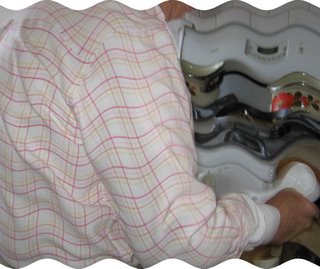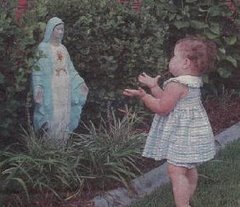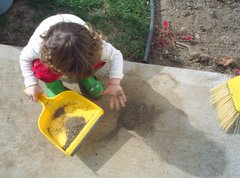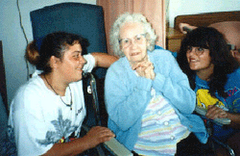 One comment to a previous post on gardening asked how beautifully straight rows of vegetables with no weeds was obtained. My answer is that you need to hoe--not a lot, but definitely at the right time. This is what we did when my Grandmother lived across the road on her ten acres and Mother took care of our five acres while my Dad was in the Army during WWII.
One comment to a previous post on gardening asked how beautifully straight rows of vegetables with no weeds was obtained. My answer is that you need to hoe--not a lot, but definitely at the right time. This is what we did when my Grandmother lived across the road on her ten acres and Mother took care of our five acres while my Dad was in the Army during WWII.First, the hired man used Grandma's horse to
 till the soil before seeds and young plants were placed in the ground. To make straight rows, two sharpened sticks with string made a line to follow for planting.
till the soil before seeds and young plants were placed in the ground. To make straight rows, two sharpened sticks with string made a line to follow for planting.A narrow, horse-pulled tiller could be used once
 between the rows of new vegetables. [Now the motorized garden tiller replaces the horse to till the soil between the narrow rows, yet not disturb the plants.] Now I use an old manual rototiller bought at an auction. But it was and still is necessary to use a hoe after the plants begin to spread their foliage.
between the rows of new vegetables. [Now the motorized garden tiller replaces the horse to till the soil between the narrow rows, yet not disturb the plants.] Now I use an old manual rototiller bought at an auction. But it was and still is necessary to use a hoe after the plants begin to spread their foliage.The first rule of hoeing was to use a sharp hoe.
 The cutting edge of a new hoe was thinned by hammering the hoe blade held against an anvil. Only when the forward and side edges were thinned sufficiently was a file used to sharpen the blade. After hoeing, the hoe was cleaned (with a stick and oily rag or crumpled aluminum foil) and stored for future use.
The cutting edge of a new hoe was thinned by hammering the hoe blade held against an anvil. Only when the forward and side edges were thinned sufficiently was a file used to sharpen the blade. After hoeing, the hoe was cleaned (with a stick and oily rag or crumpled aluminum foil) and stored for future use.My Grandmother used two different hoes, depending on the soil and weed conditions.
 A newer hoe with a larger blade was used to dig more deeply into compacted soil. The second hoe was much older, yet highly prized, with the blade mostly worn away. The old hoe was much lighter and you could work faster to cut small weeds only slightly below the ground level. In other words, you only skimmed the surface with this hoe.
A newer hoe with a larger blade was used to dig more deeply into compacted soil. The second hoe was much older, yet highly prized, with the blade mostly worn away. The old hoe was much lighter and you could work faster to cut small weeds only slightly below the ground level. In other words, you only skimmed the surface with this hoe.When hoeing, I was told to advance forward with relatively short arcs of hoeing and not take too much soil at a time. It's easier that way. I never stepped unnecessarily on the ground that had been hoed. If I did, the footprints compressed the soil and weeds could regrow more easily. I've learned to step on the side of a hoed path and re-hoe my footprints to loosen the trampled soil.
If your hoe hit a rock, it was always necessary to pick up the rock so that next year or the following years the same rock would not again dull the hoe blade. When you see rock walls around old farm fields, I believe this was one of the reasons they were built.
The most important rule of hoeing is that it must be done whenever little weeds begin to grow. My Mother must have told me twenty times that hoeing is easy when weeds are small, and the work is so much harder when the weeds are large and well established. I've learned this lesson the hard way more than a few times! [A good lesson with regard to bad habits!]
Hoeing is usually done in hot weather. Get used to it. Definitely wear a wide-brimmed straw hat and a long-sleeved old thin shirt to protect against the sun. Bring drinking water to the garden, even if you plan to go back into the house to take breaks.
When you teach your children to hoe (perhaps 8+ years old), let them hoe for no more than 15 min. Then let them play for a similar time period before they start again. Teach them the right way to hoe. Yes, they'll complain, but it will be good for them to learn to work well. Even better, give your children their own space or row within the garden in which they plant, hoe, and harvest their own berries and vegetables.
My family will always remember that my brother was the King of the County Garden Fair. He was about ten or eleven when he raised onions, tomatoes, and other vegetables. Mother told him to take the garden area where she dumped old vegetation and which had a high organic matter content. Before planting, the garden was fertilized with old composted chicken manure, and perhaps lime was added to reduce soil acidity. [The smell of ammonia/nitrogen was much more pungent with chicken manure than with cow manure.] The spot chosen to grow the contest vegetables also was closest to the faucet which could supply water to the garden when needed.
I especially remember the giant onions and beautiful tomatoes that won the contest. The secret to the onions was to plant them not very deep and to keep the upper soil around them always very loose so they could expand. [A sandy soil also helps.] The tomatoes required watering, but not too much or the skin would crack. Hoeing--YES. That was always necessary in making sure the top soil was loose and free of weeds that would steal the moisture and nutrients.
I don't remember mulching the garden plants, except to place manure close to the plants, yet not too close to burn the roots. If I were younger, I think I'd buy one of the rotating barrels for sale on the internet so that grass clippings could become compost within about a 3-week period. One of my friends uses one and he highly recommends it. I think I'd make my own tumbling composter as is described at WikiHow.









3 comments:
Dust I Am: You put me to shame. I had no idea there was so much technique to hoeing. I've been hoeing for years, of course, and lately I've been at it almost every day. But I've never sharpened a hoe in my life, nor have I been mindful of proper timing and method. Thank you!
Just wanted to add that the photos were very helpful. Thanks again. Now back to the garden ...
I rememberd being young, felt old, and went out on the porch to nap.
Post a Comment